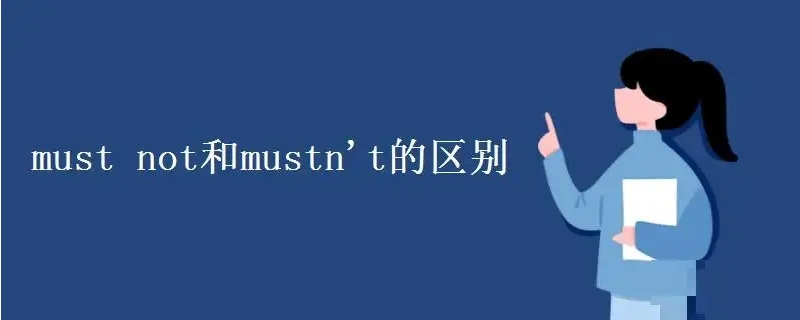

must表示必须;must not表示禁止,是说话人强有力的劝告或命令,意为“一定要,不准”。在遇到 must 有关的句子时,首先要确定它在句中的词义,看看是“必须”,还是“一定”。
1、must作为“必须”用时,它的否定形式是mustn't,意为“禁止、不准”,比如:You mustn't take the book out of the reading room. 你不准把书带出阅览室。Everyone mustn't make a noise here. 大家不准出声。
2、第二个意思是“肯定、一定”,用来表示推测,这个时候往往是must be结构:That boy must bePaul. 那个男孩肯定是保罗。He must be mad. 他一准是疯了。
当“一定”讲,表示肯定的推测时,其否定形式是can't,我们就把以上三例改为否定句:That boy can't be Paul. 那个男孩不可能是保罗。He can't be mad. 他不可能疯了。It can't be June 5th today. 今天不可能是6月5号。He can't be mad. 他不可能疯了。
3、关于must的另一个考点是这个词引导的一般疑问句的回答,也跟其有两个含义有关。
作为“必须”的时候:Must you hand in your report today? 你的报告今天就必须交上吗?---Yes, I must. 是的,必须交上。
作为“一定”表示肯定的推测时:Must he be in the library? 他一定在图书馆吗?---Yes, he must. 是的,一定。No, he can't. 不,不可能。

梦见鞭炮声什么意思(梦见鞭炮声响是啥意思)
1、梦见鞭炮声通常是比较好的事情,其他人工作或生活的改变,给你也带来了一定的利益或改变,与声音有关的梦境,一般都是你现实中听到的一些事情,给你自己造成一种心理提示与情绪感受。2、你梦中听到的鞭炮声音是反映你身边其他人的生(0)人阅读时间:2023-03-15
女人梦见收拾屋子意味着什么 女人梦见收拾屋子意味着什么呢
1、女人梦见收拾屋子,表示你能够财运亨通。 2、女人梦见收拾屋子,说谎与虚张声势是很容易就被拆穿的,这两天还是需以实力表现才好。而且这两天先下手不一定占优势,有时候也要给些缓冲时间等待时机。此外,这两天表现出对金钱观较(0)人阅读时间:2023-03-15
女人梦见抱小孩意味着什么 女人梦见抱小孩什么征兆
1、梦者梦到怀抱小孩,多是由于近日有了与小孩有关的事,如孕者即将生育,如无子夫妇有了打算生育小孩的计划,或者自己小孩近日有了什么麻烦,如疾病、升学、工作上的麻烦等。对于这样的梦境,一般没有多大意义,因为这是人们日所思、夜(0)人阅读时间:2023-03-15
微波炉可以放烤箱上吗 微波炉可以放在烤箱上吗
1、肯定是不能将微波炉放在烤箱上,也不能将烤箱放在微波炉上的。这样做影响微波炉和烤箱的散热,不仅会减少电器的使用寿命,严重的话,甚至会起火。 2、如果是并排放置,也要注意给微波炉烤箱之间留出缝隙。微波炉与顶部壁柜距离至(0)人阅读时间:2023-03-15梦见鞭炮声什么意思(梦见鞭炮声响是啥意思)
 1、梦见鞭炮声通常是比较好的事情,其他人工作或生活的改变,给你也带来了一定的利益或改变,与声音有关的梦境,一般都是你现实中听到的一些事情,给你自己造成一种心理提示与情绪感受。2、你梦中听到的鞭炮声音是反映你身边其他人的生..2023-03-15
1、梦见鞭炮声通常是比较好的事情,其他人工作或生活的改变,给你也带来了一定的利益或改变,与声音有关的梦境,一般都是你现实中听到的一些事情,给你自己造成一种心理提示与情绪感受。2、你梦中听到的鞭炮声音是反映你身边其他人的生..2023-03-15女人梦见收拾屋子意味着什么 女人梦见收拾屋子意味着什么呢
 1、女人梦见收拾屋子,表示你能够财运亨通。 2、女人梦见收拾屋子,说谎与虚张声势是很容易就被拆穿的,这两天还是需以实力表现才好。而且这两天先下手不一定占优势,有时候也要给些缓冲时间等待时机。此外,这两天表现出对金钱观较..2023-03-15
1、女人梦见收拾屋子,表示你能够财运亨通。 2、女人梦见收拾屋子,说谎与虚张声势是很容易就被拆穿的,这两天还是需以实力表现才好。而且这两天先下手不一定占优势,有时候也要给些缓冲时间等待时机。此外,这两天表现出对金钱观较..2023-03-15女人梦见抱小孩意味着什么 女人梦见抱小孩什么征兆
 1、梦者梦到怀抱小孩,多是由于近日有了与小孩有关的事,如孕者即将生育,如无子夫妇有了打算生育小孩的计划,或者自己小孩近日有了什么麻烦,如疾病、升学、工作上的麻烦等。对于这样的梦境,一般没有多大意义,因为这是人们日所思、夜..2023-03-15
1、梦者梦到怀抱小孩,多是由于近日有了与小孩有关的事,如孕者即将生育,如无子夫妇有了打算生育小孩的计划,或者自己小孩近日有了什么麻烦,如疾病、升学、工作上的麻烦等。对于这样的梦境,一般没有多大意义,因为这是人们日所思、夜..2023-03-15微波炉可以放烤箱上吗 微波炉可以放在烤箱上吗
 1、肯定是不能将微波炉放在烤箱上,也不能将烤箱放在微波炉上的。这样做影响微波炉和烤箱的散热,不仅会减少电器的使用寿命,严重的话,甚至会起火。 2、如果是并排放置,也要注意给微波炉烤箱之间留出缝隙。微波炉与顶部壁柜距离至..2023-03-15
1、肯定是不能将微波炉放在烤箱上,也不能将烤箱放在微波炉上的。这样做影响微波炉和烤箱的散热,不仅会减少电器的使用寿命,严重的话,甚至会起火。 2、如果是并排放置,也要注意给微波炉烤箱之间留出缝隙。微波炉与顶部壁柜距离至..2023-03-15